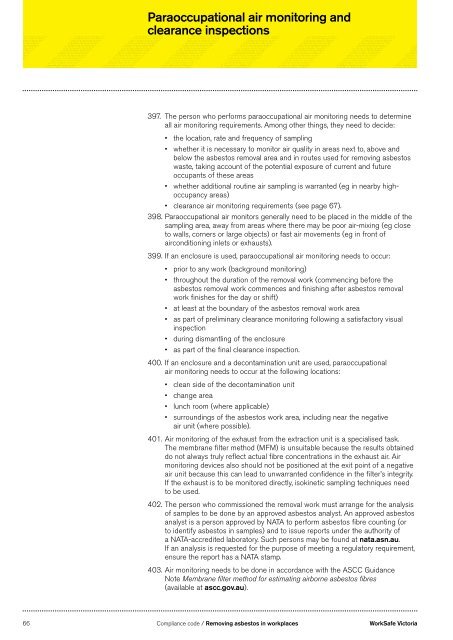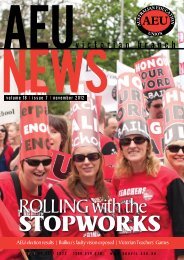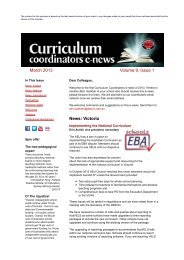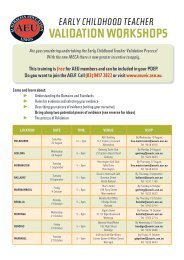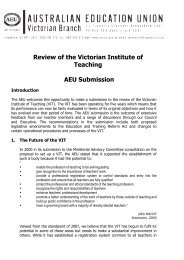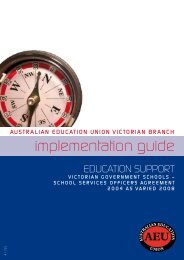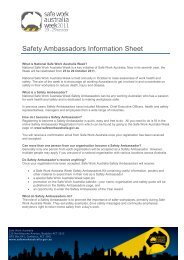Removing asbestos in workplaces - Compliance ... - WorkSafe Victoria
Removing asbestos in workplaces - Compliance ... - WorkSafe Victoria
Removing asbestos in workplaces - Compliance ... - WorkSafe Victoria
You also want an ePaper? Increase the reach of your titles
YUMPU automatically turns print PDFs into web optimized ePapers that Google loves.
Paraoccupational air monitor<strong>in</strong>g andclearance <strong>in</strong>spections397. The person who performs paraoccupational air monitor<strong>in</strong>g needs to determ<strong>in</strong>eall air monitor<strong>in</strong>g requirements. Among other th<strong>in</strong>gs, they need to decide:• the location, rate and frequency of sampl<strong>in</strong>g• whether it is necessary to monitor air quality <strong>in</strong> areas next to, above andbelow the <strong>asbestos</strong> removal area and <strong>in</strong> routes used for remov<strong>in</strong>g <strong>asbestos</strong>waste, tak<strong>in</strong>g account of the potential exposure of current and futureoccupants of these areas• whether additional rout<strong>in</strong>e air sampl<strong>in</strong>g is warranted (eg <strong>in</strong> nearby highoccupancyareas)• clearance air monitor<strong>in</strong>g requirements (see page 67).398. Paraoccupational air monitors generally need to be placed <strong>in</strong> the middle of thesampl<strong>in</strong>g area, away from areas where there may be poor air-mix<strong>in</strong>g (eg closeto walls, corners or large objects) or fast air movements (eg <strong>in</strong> front ofaircondition<strong>in</strong>g <strong>in</strong>lets or exhausts).399. If an enclosure is used, paraoccupational air monitor<strong>in</strong>g needs to occur:• prior to any work (background monitor<strong>in</strong>g)• throughout the duration of the removal work (commenc<strong>in</strong>g before the<strong>asbestos</strong> removal work commences and f<strong>in</strong>ish<strong>in</strong>g after <strong>asbestos</strong> removalwork f<strong>in</strong>ishes for the day or shift)• at least at the boundary of the <strong>asbestos</strong> removal work area• as part of prelim<strong>in</strong>ary clearance monitor<strong>in</strong>g follow<strong>in</strong>g a satisfactory visual<strong>in</strong>spection• dur<strong>in</strong>g dismantl<strong>in</strong>g of the enclosure• as part of the f<strong>in</strong>al clearance <strong>in</strong>spection.400. If an enclosure and a decontam<strong>in</strong>ation unit are used, paraoccupationalair monitor<strong>in</strong>g needs to occur at the follow<strong>in</strong>g locations:• clean side of the decontam<strong>in</strong>ation unit• change area• lunch room (where applicable)• surround<strong>in</strong>gs of the <strong>asbestos</strong> work area, <strong>in</strong>clud<strong>in</strong>g near the negativeair unit (where possible).401. Air monitor<strong>in</strong>g of the exhaust from the extraction unit is a specialised task.The membrane filter method (MFM) is unsuitable because the results obta<strong>in</strong>eddo not always truly reflect actual fibre concentrations <strong>in</strong> the exhaust air. Airmonitor<strong>in</strong>g devices also should not be positioned at the exit po<strong>in</strong>t of a negativeair unit because this can lead to unwarranted confidence <strong>in</strong> the filter’s <strong>in</strong>tegrity.If the exhaust is to be monitored directly, isok<strong>in</strong>etic sampl<strong>in</strong>g techniques needto be used.402. The person who commissioned the removal work must arrange for the analysisof samples to be done by an approved <strong>asbestos</strong> analyst. An approved <strong>asbestos</strong>analyst is a person approved by NATA to perform <strong>asbestos</strong> fibre count<strong>in</strong>g (orto identify <strong>asbestos</strong> <strong>in</strong> samples) and to issue reports under the authority ofa NATA-accredited laboratory. Such persons may be found at nata.asn.au.If an analysis is requested for the purpose of meet<strong>in</strong>g a regulatory requirement,ensure the report has a NATA stamp.403. Air monitor<strong>in</strong>g needs to be done <strong>in</strong> accordance with the ASCC GuidanceNote Membrane filter method for estimat<strong>in</strong>g airborne <strong>asbestos</strong> fibres(available at ascc.gov.au).66 <strong>Compliance</strong> code / <strong>Remov<strong>in</strong>g</strong> <strong>asbestos</strong> <strong>in</strong> <strong>workplaces</strong> <strong>WorkSafe</strong> <strong>Victoria</strong>


